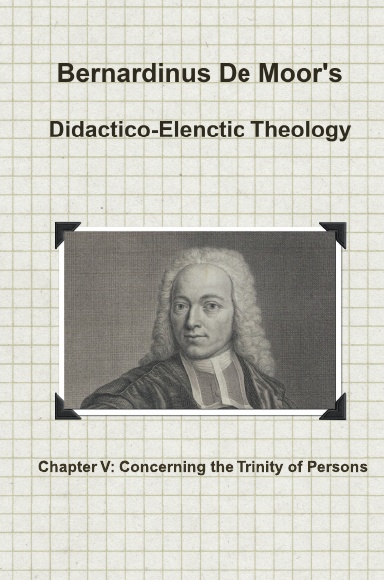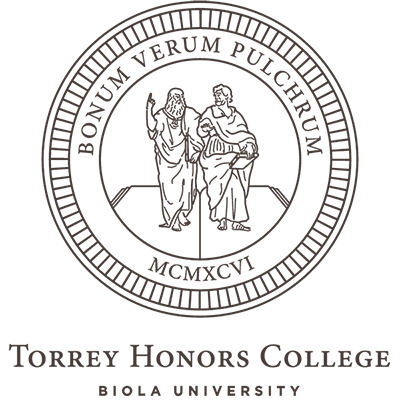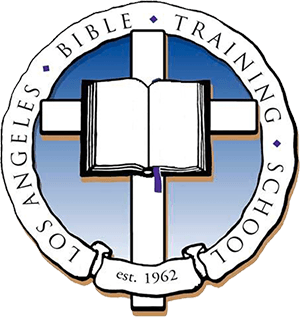A scene from The Canterbury Psalter (12th century)
Blog
De Moor De Trinitate

I just picked up the first-ever English translation of Bernardinus de Moor’s eighteenth-century work on the Trinity. Running 382 pages and costing $50 hardcover, it’s a good book and I’m glad to have it. Here’s why.
De Moor (1709-1780) was a theology professor at Leiden from 1745 until his death, and his theological project was essentially conservative. He liked the Protestant Orthodox system and intended to preserve and extend it. Willem J. van Asselt said “de Moor classified and combined material from the Reformed dogmatics produced by his predecessors at Utrecht and Leiden into a whole.” In particular, de Moor’s major production took the form of an expansive running commentary on a rather concise theological system by one of his teachers, Johannes à Marck. So de Moor’s multivolume theology has the title Continuous Commentary on Johannes à Marck’s Compendium of Didactico-Elenctic Christian Theology (Commentarius Perpetuus in Johannes Marckii Compendium Theologiae Christianae Didactico-Elenchticum). It was published in seven very large volumes, but consider this: this Trinity volume is a large hardcover in its own right, and it’s only one chapter (chapter 5) of the 34 chapters in de Moor’s seven volumes. This suggests that de Moor in English might run to dozens of volumes.
Steven Dilday has undertaken to get de Moor into English and into print. He’s several volumes into the project now. Check out his site for the whole enterprise. Two things worth noticing: first, there are vast quantities of free translations available to read at his website, and second, you can go and buy the bound volumes from his author page at self-publishing hub Lulu. They’re not cheap, but they’re well printed and solidly bound. I’ve used some of Dilday’s work over the past few years (volume 1 came out in 2014), but of course I’ve been waiting for this Trinity volume. And here it is! I’m biased this way, but I think a theological project really picks up steam when it gets to the Trinity. So check out Dilday’s de Moor project, and consider a purchase.
On the “didactico-” side of Didactico-Elenctic, de Moor is concerned to teach “the doctrine of the Trinity of persons” in a well-ordered way, which generally means building it up from its basic principles. For him, that includes starting with the vocabulary: the “etymology, synonym, and homonymy” of the key terms Trinity and person. After that, he explains the doctrine in four propositions:
- There is only One Essence in God
- In God there are also Three Persons, which are abstractly Incommunicable Modes of Subsistence of the Divine Essence
- These Persons Agree among themselves [in essence, equality, and perichoresis]
- The Same are Distinguished among Themselves [in name, order, mode of operation, works ad extra by appropriation, and especially by personal properties]
Even from this outline you can see a kind of double movement from unity to Trinity. The first pair of points move from one essence to three persons, while the next pair moves from agreement to distinction.
Once he has mentioned the personal properties of the persons, de Moor launches out onto more extended treatments of Father, Son, and Holy Spirit. Following that, he works through biblical testimonies (Old and then New Testaments). It’s a good plan of ordering things, and once you’ve got it figured out it’s pretty easy to find where the key discussions are.
On the “-elenctic” side of Didactico-Elenctic, de Moor devotes considerable space to entertaining objections and refuting opponents. There is a debating element to his style throughout, but after establishing the basic lines of his doctrine, de Moor comes back to defend elements of the doctrine by refuting opponents by name.
If you compare de Moor with earlier writers in this tradition like Junius or Polanus, you note that in some sub-sections he does in fact have quite a bit more to say than his predecessors. I found his expansive explanation of consubstantiality helpful: Polanus is a bit delphic in commending homoousios over monoousios or tautoousios, but de Moor comes right out and says “mono-ousios…could be used of God even if in the Numerically One Essence there were only one Person subsisting,” and “tauto-ousios…could be drawn to designate one that in Essence is the same with another in such a way that all personal distinction in the mode of subsistence is prevented.” (78) This is a typical example of how de Moor is later and more compendious: he tends to draw together what many have said, and to draw out at greater length the explanations. This is usually helpful, though (depending on the depth of your interest in these matters) in a few stretches de Moor does kind of belabor a point.
De Moor also tends to provide more bibliographical references, and more precise ones, than earlier Reformed Orthodox authors. Of course most of these references take some work to navigate: his patristic references are keyed to editions available in the eighteenth century, and there’s often slippage. Dilday consistently identifies authors with short biographic notes, but doesn’t generally do a lot of work indicating where to find current versions of the texts (even in cases where de Moor cites pseudo-Athanasius as Athanasius, and similar cases). Also, several of de Moor’s sources are in Dutch and Dutch alone. In my opinion, all of this is perfectly appropriate: Dilday is giving us a very readable English version of a Latin text, not building a scholarly interface to open up the whole eighteenth-century world of discourse. That’s fine.
In one sense, reading this conservative Leiden theology from the 1770s is time-travelling to the period just before the deluge of the nineteenth century. Already authors in this time period are interacting with Descartes and Hobbes (as de Moor does). The world is changing; Kant is already working on critiques, and Hegel and Schleiermacher are just a couple of decades away. What was a fundamentally conservative teacher like de Moor up to?
A couple of things stand out. First, de Moor gives the Johannine Comma a special prominence, as the capstone of his entire Biblical proof: “Yet above all these the passage 1 John 5:7 rises.” (241) He devotes 21 pages to it. But those pages offer scant commentary on its actual theology; they are instead devoted to critical inquiry, defending the text’s authenticity using numerous strategies. By contrast, consider how Thomas Goodwin (d. 1680) handled the text: It was the basis of his lively work Man’s Restoration by Grace, sub-titled “a Discourse of the Several parts which the Three Persons of the Godhead, bear in the accomplishment of our Salvation.” In Goodwin’s case, if we consider the Johannine Comma spurious, we might now wish he had built his exercise in spiritual theology on a different textual basis. In de Moor’s case, the whole 21-page section is exclusively a critical essay seeking to demonstrate the authenticity of the text.
A happier example is the space de Moor gives to refuting Röellius (151-169), who is a crucially important figure in the early modern rejection of the doctrine of eternal generation. Later generations would increasingly struggle with a sense that this ancient doctrine simply stopped seeming plausible in the wider intellectual culture. A genealogy of the decline of eternal generation’s plausibility still needs to be written, since defenders of the doctrine always seem to be working against an inscrutable tide. The opportunity to read De Moor versus Röellius is a rich one, not just because de Moor’s argumentation is effective, but because it enables us to catch the back-and-forth polemics on this issue at exactly the time period when the major new positions were forming. Röellius worked hard to establish his view and make it attractive. In my view, de Moor decisively won the debate, but the ongoing, anonymous influence of Röellius’ case is very much still with us.
In the two examples above, de Moor gives the impression of being a writer who likes a good fight, and especially a fight in which copious documentary material is ready at hand for forming arguments. There is some disproportion in the amount of space he allocates to topics like the two just mentioned, but it is probably to be accounted for by the fact that the material for these arguments was plentiful. This feistiness or doggedness is also on display when de Moor traces his way through a difficult history of interpretation of a Biblical passage (who were the three men who appeared to Abraham under the oaks of Mamre, in Trinitarian terms?). De Moor excels at presenting pro- and con- cases for conflicting interpretations of a key text, definitely taking a side, but nicely airing all the issues of both sides.
One last observation: De Moor’s system is didactic and elenctic, but not directly practical or devotional. He is aware of the importance of the doctrine for Christian prayer and work, but he puts off any real discussion of this until the final pages. There, in three chapters, he briefly notes “the sublimity of the doctrine of the Trinity” (fascinating heading, that!), “the necessity of the doctrine,” and “the utility of the doctrine.” These are all nicely handled. But they are brief comments after the work has been done. By contrast, consider how Petrus van Mastricht works the devotional or practical angle in every section of his work on the Trinity (Theoretico-Practical Theology, vol. 2). I don’t make this comparison to warn readers off of de Moor, but to alert them to what to expect from him. Clear and copious commentary on received doctrine is the name of his game, and he delivers extremely well. This volume is a storehouse of valuable things, and I recommend it.
About This Blog

Fred Sanders is a theologian who tried to specialize in the doctrine of the Trinity, but found that everything in Christian life and thought is connected to the triune God.


